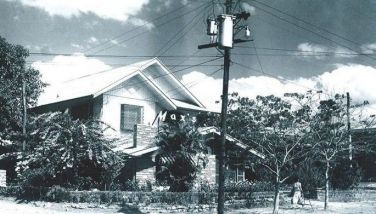Winter solstice as Christmas

December 19, 2004 | 12:00am
The idea of a Christmas that does not pay homage to the birth of a messiah has been around for centuries before the link was made. The original celebration of ‘Christmas’ was pagan and nature-oriented. It revolved around the winter solstice. There are two solstices in the year, one on June 21 and the other on December 22. It is at the point when the Sun is said to be furthest from the celestial equator. In June the Sun is at the northernmost point of its apparent path when the northern side of the earth has its longest day and the south has its longest night. In December, the positions are reversed. At this time it is the Northern hemisphere which has the longest night.
The end of the winter solstice, of long nights was celebrated with grand feasting. Plentiful food was prepared and shared for the coming harvests. Our own modern Christmas echoes this pagan feasting when we decorate our houses, shop until we drop and gorge ourselves with food. The pagan feast is known as the Roman Saturnalia which honored the god of the harvest, Saturn today, the 19th of December. The festivities themselves lasted for seven days. A parallel event in northern Europe called Yule was also celebrated with giant logs, trimmed with greenery and ribbons. These were later burnt in honor of the gods to encourage the sun to shine more brightly.
So how did the modern celebration of Christmas develop out of what had been a pagan festival? Some answers or more appropriately, questions can be gleaned from Time magazine’s December cover story, Secrets of the Nativity. Essentially it says that there is no hard evidence on the literal truth of the gospel. The Gospels of Matthew and Luke differ on the details and key points of the story, or that Christmas Day should fall on December 25 because there is also no definitive proof that Jesus Christ was born on that day. The gospels do not mention any date, either. The celebration of Christmas as the birth date of Jesus Christ on December 25 began with Pope Julius I around 350 C. Rather than suppress the pagan rituals of this season, Pope Julius, as with most of the early Church leaders incorporated the pagan rites of the winter solstice and the coming spring with the Christian Christmas.
The belen and Christmas carols were added through the years but the core of the celebrations is the feasting which echoes the pagan rituals. For a time there was no Christmas in Britain when the Puritans banned it in the 17th century and continued the ban even when they had moved to Massachusetts.
Christmas as we celebrate it today is a 19th-century invention – the decorated Christmas tree, carol-singing, and Christmas cards. Santa Claus, complete with sleigh, reindeers, and his sack of toys, is an American invention which first appeared in a drawing by Thomas Nast in Harper’s magazine in 1868. But there is another legend of Father Christmas derived from St. Nicholas who is a jovial medieval figure, symbolizing the "spirit of Christmas".
All this is not to shun the Christmas celebrations all around us today, more so in the Philippines, which takes pride in being the only Christian country in Asia. By all means celebrate but we must not think of the season as exclusively belonging to Christians. Christmas is as much a secular festival as a religious one and therefore belongs to everyone. I think knowing that background would make us more tolerant. Instead of wondering why the Buddhist Chinese, the Indian Hindu, or the Shintoist Japanese celebrate ‘Christmas’ just as merrily as Christians. The question is why not? If festivities at this time of the year came originally from pagan forebears, no one should be left out. Only then can the shopping, feasting and gift giving be justified in what would otherwise be just a commercial excuse for the manufacturers to unload their products and stores to make their sales and profits.
Although the traditional Filipino Christmas has lechon as its centerpiece, we have adopted many Christmas customs from both Spaniards and Americans. Having lived in Great Britain for many years our children and their families are looking forward to a Christmas meal of smoked salmon and turkey. They have brought home Christmas pudding and mince pies without which an English Christmas meal is incomplete. I refer to these as ‘exile’ food. The Filipino part of our celebrations is the media noche when we have a modest meal of arroz caldo and puto bumbong or if we want to pass the carbohydrates, we’ll just have hot pancit molo. Midnight Mass is optional but opening of gifts around the Christmas tree is de rigueur.
UNDERGROUND ECONOMY. I sat next to a top Japanese executive at a lunch recently. He was touring Asia to look at the end of year reports on their investments. I thought I should strike a conversation with him to let him know that whatever he was looking at about the economic conditions of the Philippines may likely be off mark. I said, there was a large underground economy for which there are no figures. But it is visible in the vibrant life at least in and around Manila and other big cities in the country – Filipinos were shopping, eating in restaurants. They are spending, wherever that money comes from. Admittedly it is consumer-led but who is to say it is not about economic well being. He looked at me askance and said I know that. I added that even the figure 6.3 per cent contradicted the doomsayers. Then he surprised me. "As far as I am advised by colleagues watching this country, whenever an economic figure such as the 6.3 per cent is trotted out, multiply that by double to make up for the unreported underground economy and you will get a more accurate picture of the country. Most of these investors are quite aware of the economic potential of this country. What disconcerts them is the lack of continuity and stability of the structure of government. You may differ with that but this is the view of a businessman whose job is to make sure that their investments are secure.
MISLEADING SURVEYS. I was glad to have my son around from Singapore not just for the Christmas holidays but because he helped me understand what the SWS surveys mean. He said the SWS survey reporting a negative net satisfaction with the Arroyo government can be misleading. Of course there is no such think as a 100 per cent satisfaction, least of all in a divided and politicized country.
To say that there is she still has a negative net satisfaction means only that - there are people who are dissatisfied with the government. I am passing on his explanation to readers of this column. It means is said that if SWS had interviewed 45 people, 40 said they were satisfied and 5 said they were not satisfied. If it is reported in that manner then it changes its meaning altogether. Indeed there is a positive outlook if out of 45, ony 5 are dissatisfied. But then when a front page juxtaposes this survey with another story about how 75.6 percent businessmen dissatisfied with government it says more about the editorial intent of the newspaper than it does about its civic duty to informing the public.
E-mail: cpedrosa@edsamail.com.ph
The end of the winter solstice, of long nights was celebrated with grand feasting. Plentiful food was prepared and shared for the coming harvests. Our own modern Christmas echoes this pagan feasting when we decorate our houses, shop until we drop and gorge ourselves with food. The pagan feast is known as the Roman Saturnalia which honored the god of the harvest, Saturn today, the 19th of December. The festivities themselves lasted for seven days. A parallel event in northern Europe called Yule was also celebrated with giant logs, trimmed with greenery and ribbons. These were later burnt in honor of the gods to encourage the sun to shine more brightly.
So how did the modern celebration of Christmas develop out of what had been a pagan festival? Some answers or more appropriately, questions can be gleaned from Time magazine’s December cover story, Secrets of the Nativity. Essentially it says that there is no hard evidence on the literal truth of the gospel. The Gospels of Matthew and Luke differ on the details and key points of the story, or that Christmas Day should fall on December 25 because there is also no definitive proof that Jesus Christ was born on that day. The gospels do not mention any date, either. The celebration of Christmas as the birth date of Jesus Christ on December 25 began with Pope Julius I around 350 C. Rather than suppress the pagan rituals of this season, Pope Julius, as with most of the early Church leaders incorporated the pagan rites of the winter solstice and the coming spring with the Christian Christmas.
The belen and Christmas carols were added through the years but the core of the celebrations is the feasting which echoes the pagan rituals. For a time there was no Christmas in Britain when the Puritans banned it in the 17th century and continued the ban even when they had moved to Massachusetts.
Christmas as we celebrate it today is a 19th-century invention – the decorated Christmas tree, carol-singing, and Christmas cards. Santa Claus, complete with sleigh, reindeers, and his sack of toys, is an American invention which first appeared in a drawing by Thomas Nast in Harper’s magazine in 1868. But there is another legend of Father Christmas derived from St. Nicholas who is a jovial medieval figure, symbolizing the "spirit of Christmas".
All this is not to shun the Christmas celebrations all around us today, more so in the Philippines, which takes pride in being the only Christian country in Asia. By all means celebrate but we must not think of the season as exclusively belonging to Christians. Christmas is as much a secular festival as a religious one and therefore belongs to everyone. I think knowing that background would make us more tolerant. Instead of wondering why the Buddhist Chinese, the Indian Hindu, or the Shintoist Japanese celebrate ‘Christmas’ just as merrily as Christians. The question is why not? If festivities at this time of the year came originally from pagan forebears, no one should be left out. Only then can the shopping, feasting and gift giving be justified in what would otherwise be just a commercial excuse for the manufacturers to unload their products and stores to make their sales and profits.
Although the traditional Filipino Christmas has lechon as its centerpiece, we have adopted many Christmas customs from both Spaniards and Americans. Having lived in Great Britain for many years our children and their families are looking forward to a Christmas meal of smoked salmon and turkey. They have brought home Christmas pudding and mince pies without which an English Christmas meal is incomplete. I refer to these as ‘exile’ food. The Filipino part of our celebrations is the media noche when we have a modest meal of arroz caldo and puto bumbong or if we want to pass the carbohydrates, we’ll just have hot pancit molo. Midnight Mass is optional but opening of gifts around the Christmas tree is de rigueur.
To say that there is she still has a negative net satisfaction means only that - there are people who are dissatisfied with the government. I am passing on his explanation to readers of this column. It means is said that if SWS had interviewed 45 people, 40 said they were satisfied and 5 said they were not satisfied. If it is reported in that manner then it changes its meaning altogether. Indeed there is a positive outlook if out of 45, ony 5 are dissatisfied. But then when a front page juxtaposes this survey with another story about how 75.6 percent businessmen dissatisfied with government it says more about the editorial intent of the newspaper than it does about its civic duty to informing the public.
BrandSpace Articles
<
>
- Latest
- Trending
Trending
Latest























